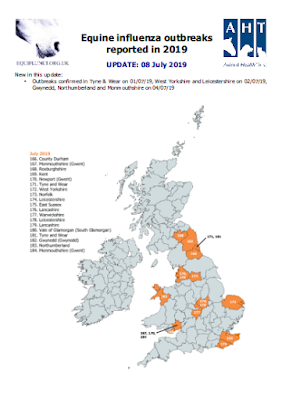 |
| Link |
#14,174
The UK's largest equine flu outbreak in nearly 2 decades continues with 19 new outbreaks reported since my last report a week ago (see UK: Equine Influenza Outbreaks Continue To Escalate).
Yesterday the UK's Animal Health Trust (AHT) issued the following update:
 |
| AHT Jul 8th Outbreak List |
Earlier this year, we followed the start of an equine influenza outbreak in the UK (see UK BHA: All Horse Racing Halted After Equine Flu Reported In Vaccinated Horses) which somewhat surprisingly, turned out to be due to the “Florida Clade 1” strain, which is endemic to North and South America.
The Clade 2 strain is endemic to Europe.After a slow start, the pace of outbreaks has begun to pick up across the UK, with 27 outbreaks reported in May, 63 outbreaks in June (revised), and 19 outbreaks in the first four days of July.
Globally, were seeing a surge in Equine influenza, with Sudan being the latest country to report an outbreak (see OIE Report).
Last April, the OIE summarized outbreaks in South America, Africa, Europe, North America, and Asia and concluded there has been an increase in global equine influenza activity over the past year.
Although the UK has been hardest hit outside of West Africa, a number of
other Western European nations have reported outbreaks since the start
of the year, with the AHT and Equiflunet.org.uk reporting on July 1st:
Outbreaks of EI in Europe
There has been an increase in equine influenza activity reported in Europe. Multiple outbreaks were reported in Northern France at the end of December, whilst positive diagnoses have been made since the beginning of 2019 in France, Belgium, Germany, Ireland, Italy the Netherlands, Denmark and Sweden.
Equine influenza is not currently considered a human health threat, it is not without zoonotic potential; it is similar to other viruses which have infected humans, and remains a virus we watch carefully.
In 2016, in Epizootics, Host Ranges, and Conventional Wisdom, we looked at the (admittedly, limited) scientific and historical evidence suggesting that equine influenza may have infected humans in the past, and could possibly do so again someday.More recently, the June edition of the CDC's EID Journal carried this cautionary review:
Volume 25, Number 6—June 2019
Historical Review
Equine Influenza Virus—A Neglected, Reemergent Disease Threat Metric Details
Alexandra Sack, Ann Cullinane, Ulziimaa Daramragchaa, Maitsetseg Chuluunbaatar, Battsetseg Gonchigoo, and Gregory C. Gray
.C. Gray)
Abstract(Continue . . .)
Equine influenza virus (EIV) is a common, highly contagious equid respiratory disease. Historically, EIV outbreaks have caused high levels of equine illness and economic damage. Outbreaks have occurred worldwide in the past decade. The risk for EIV infection is not limited to equids; dogs, cats, and humans are susceptible.
For more on the zoonotic potential of equine influenza, you may wish to revisit 2018's Equine H3N8: Looking At A long-shot In The Pandemic Sweepstakes.
